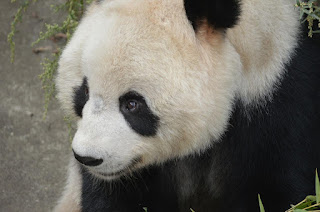
They use their enlarged wrist bones that act as opposing thumbs.
The newborn panda is about the size of a butterfly — about the weight of a mother / 1/900 — but females can grow to about 600 pounds [200 kg], and males can weigh as much as 200 pounds [300 kg].

Development is slow during the first few months. Eyes begin to open in about 45 days, and the first moving steps are taken in 75-80 days. Its self-sufficient condition authorizes birth in the cave, the habitat for the first 100-120 days of life. By about 14 months, when the milk teeth had erupted, the baby was already eating bamboo, and at 18-24 months the mother was weaned. Separation from the mother must occur before the woman can produce the next waste. Imprisoned pandas may live more than 30 years in captivity, but the life span in the wild is estimated to be 20 years.
